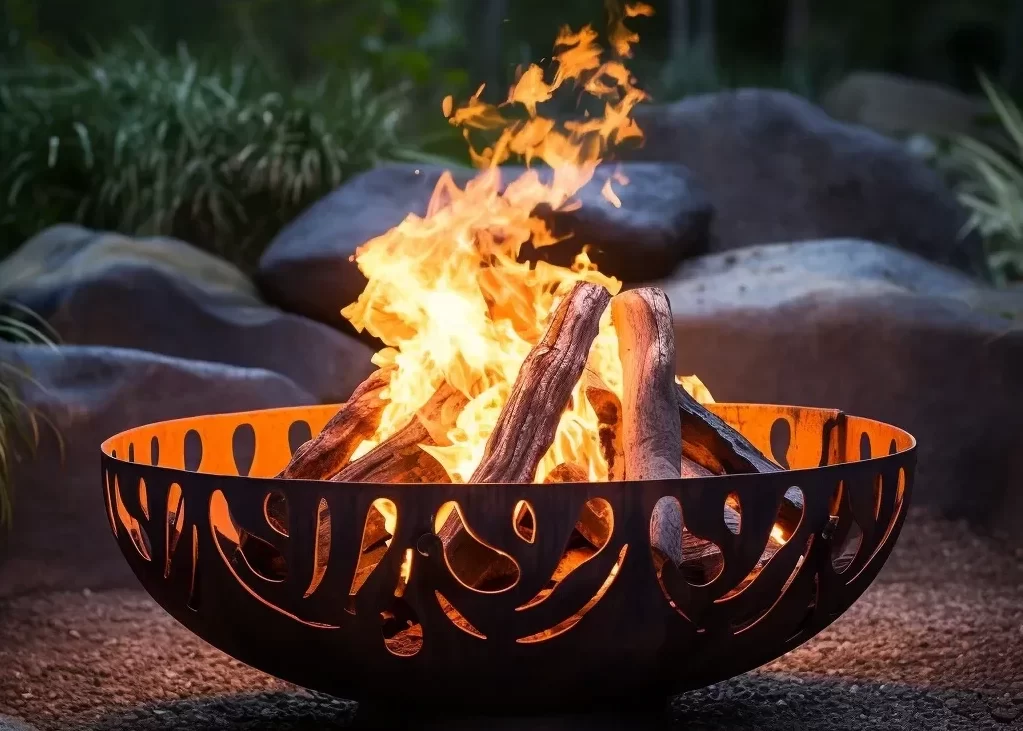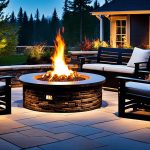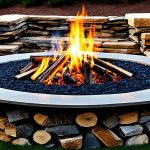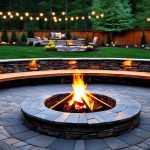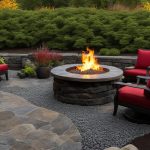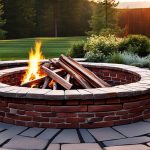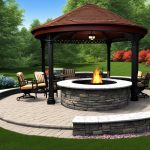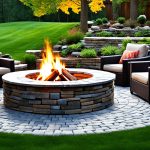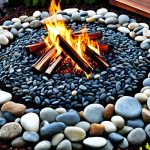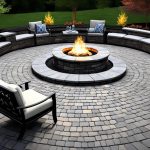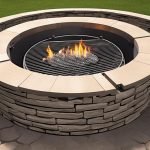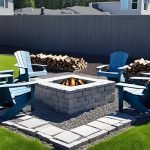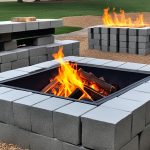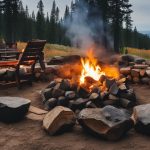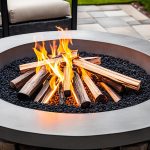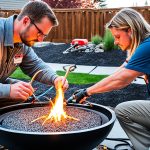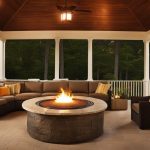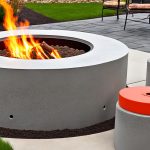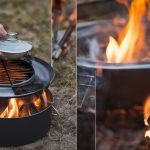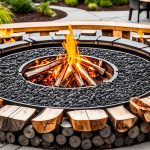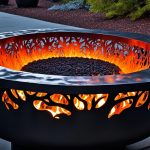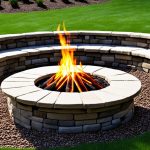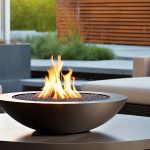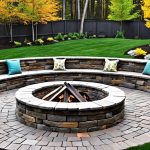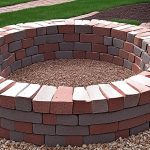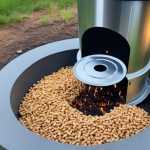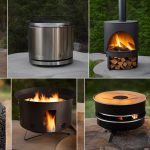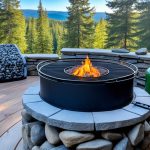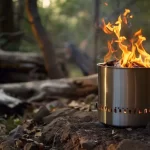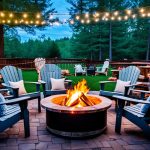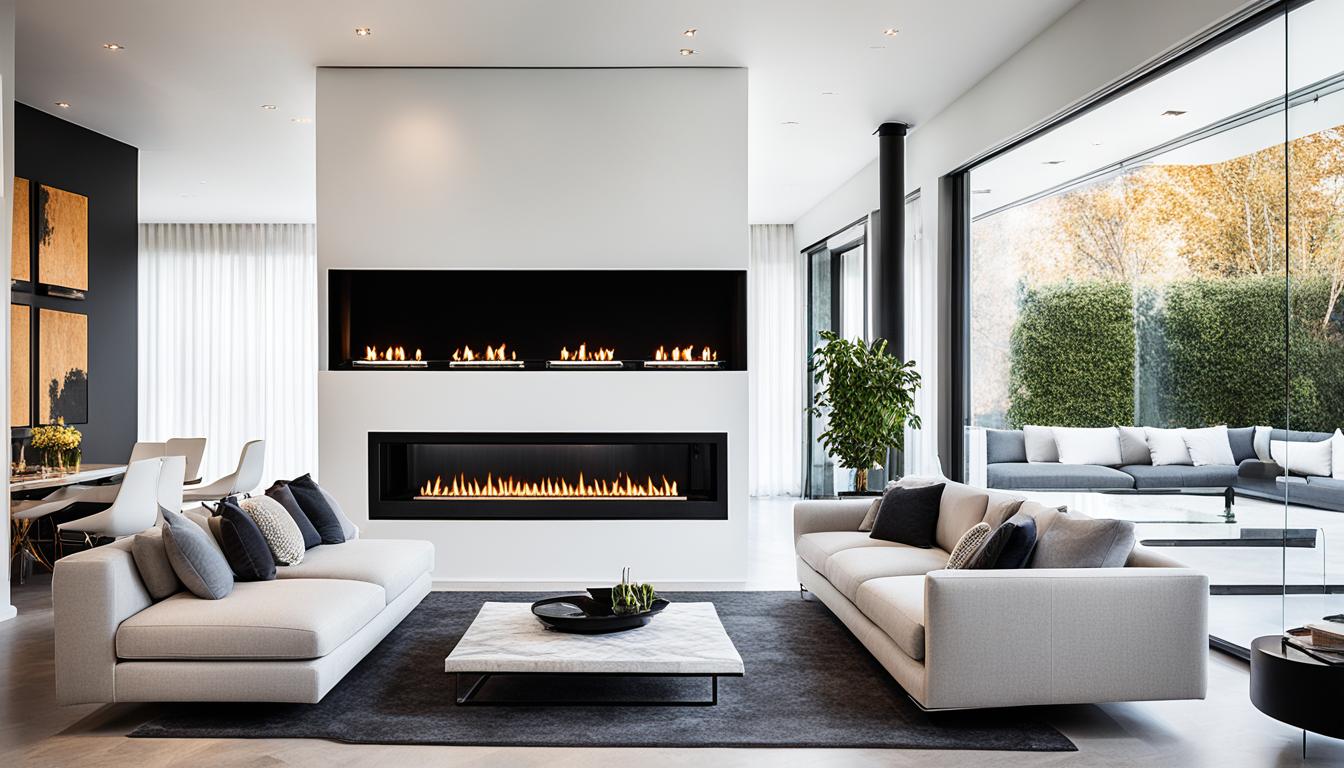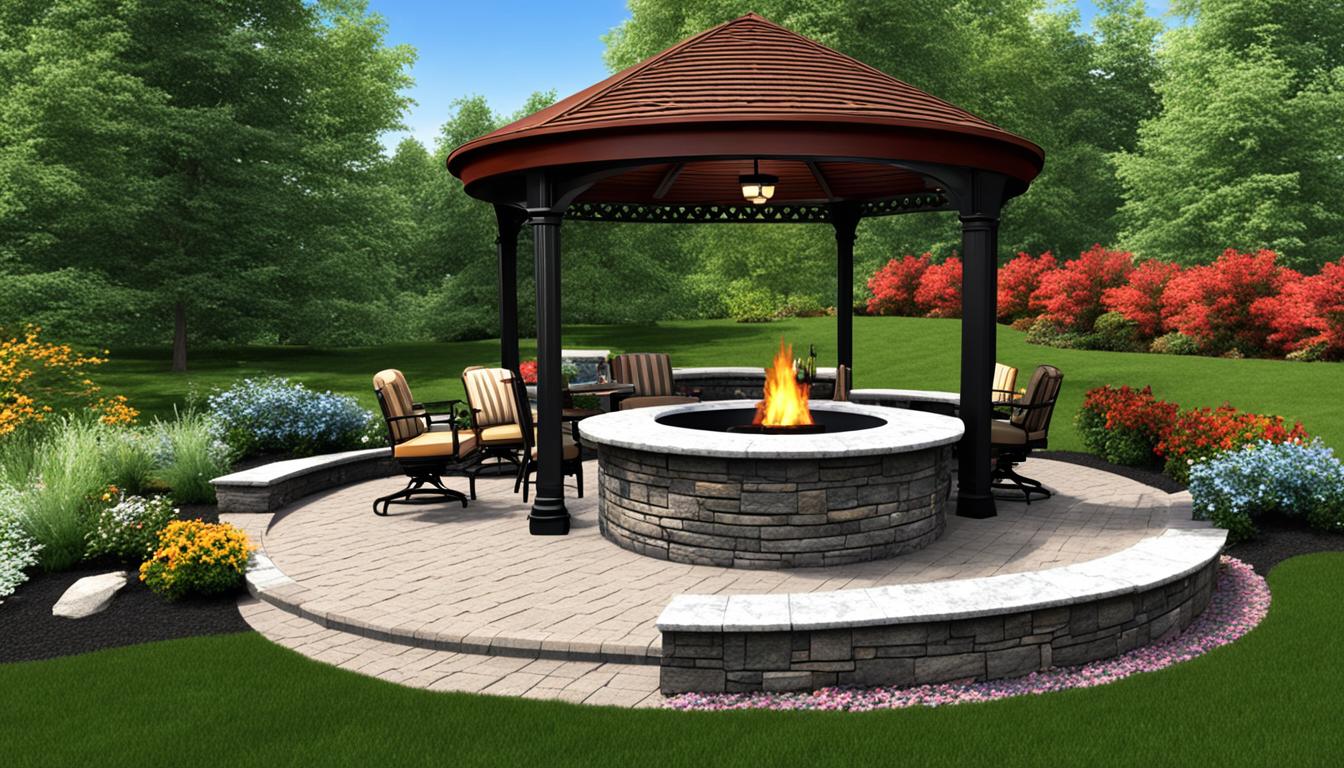
Are you tired of spending chilly evenings indoors and missing out on the warmth and ambiance of a cozy fire pit? What if I told you that you can easily build your own DIY solo stove fire pit and enjoy the great outdoors to the fullest? Get ready to ignite your outdoor adventures with this comprehensive guide to building a portable and efficient fire pit.
With just a few tools and materials, you can create a smokeless fire pit that will become the centerpiece of your outdoor space. Say goodbye to expensive commercial fire pits and hello to a cost-effective and customizable DIY solution.
Key Takeaways:
- Learn how to build a DIY solo stove fire pit step by step.
- Discover the essential tools and materials you’ll need for the project.
- Design your own fire pit area to create an inviting outdoor space.
- Explore the benefits and cost savings of a DIY solo stove fire pit compared to commercial options.
- Ensure safety and maintenance considerations for a worry-free fire pit experience.
Essential Tools and Materials for Building a DIY Solo Stove
Are you ready to embark on your DIY solo stove journey? Before you get started, it’s important to gather all the essential tools and materials you’ll need to build your own fire pit. Whether you’re a seasoned DIY enthusiast or a beginner, having the right supplies on hand will make the process smoother and more enjoyable.
Tools:
- An axe or hatchet for trimming kindling
- Matches for igniting your fire
- A propane torch for an alternative fire-starting method
Materials:
- Firewood: Choose quality firewood that burns efficiently and provides a steady source of heat. Opt for hardwoods such as oak, maple, or birch.
- Firestarter: Use a reliable firestarter to kickstart your fire. This can be purchased or made at home using dryer lint, newspaper, and Vaseline.
- Solo Stove Juniper Aromatic Firewood: Enhance the aroma of your fire with Solo Stove Juniper Aromatic Firewood, which adds a delightful fragrance to your outdoor space.
- Chunk wood: Gather chunk wood to create a solid base and promote proper airflow within your fire pit.
- Newspaper: Use newspaper as an additional firestarter or to create a base layer for your fire.
- Solo Stove Starter Packs: These convenient packs contain everything you need to start your fire, including firestarter, kindling, and matches.
–>
- Optional Materials: Consider using landscapping fabric and stakes to prevent weeds and provide stability to your fire pit. For added aesthetics, spray paint your fire pit or incorporate pavers or border material. Secure the pavers with construction adhesive and fill the pit with pea gravel for a polished look. Add Adirondack chairs for comfortable seating and enjoy long-lasting evenings by the fire.
–>
With these essential tools and materials at your disposal, you’re one step closer to creating your very own DIY solo stove fire pit. See the table below for a comprehensive list:
| Tools | Materials |
|---|---|
| Axe or hatchet | Firewood |
| Matches | Firestarter |
| Propane torch | Solo Stove Juniper Aromatic Firewood |
| Chunk wood | |
| Newspaper | |
| Solo Stove Starter Packs |
Step-by-Step Instructions for Building a DIY Solo Stove Fire Pit
Building your own DIY solo stove fire pit is a fun and rewarding project that will elevate your outdoor experience. Follow these step-by-step instructions to create your very own fire pit:
- Create Kindling: Start by gathering firewood and creating kindling. Use an axe or hatchet to trim the firewood into small, manageable pieces.
- Lay the Base: Choose a flat and safe location for your fire pit. Place the base plate in the desired spot and build a square shape using the kindling.
- Prepare Firestarters: You can make your own firestarters by using newspaper, dryer lint, and a small amount of Vaseline. Alternatively, you can use Solo Stove Starters, which are designed for optimal fire ignition.
- Add Kindling: Place the firestarters on top of the kindling and add more kindling on top. Arrange it in a cone shape to allow for proper air circulation.
- Ignite the Fire: Light the firestarters and watch as the flames begin to catch the kindling. Ensure that the fire is well-established before proceeding to the next step.
- Secondary Burn: For a smokeless fire, add firelogs under the secondary burn holes of your DIY solo stove fire pit. These burn holes promote cleaner combustion and reduce smoke.
- Use Solo Stove Firewood: For a perfect fit and optimal performance, consider using Solo Stove Firewood. These specially designed logs are crafted to burn efficiently in solo stoves and fire pits.
With these step-by-step instructions, you’ll have your DIY solo stove fire pit up and running in no time! Enjoy cozy evenings and unforgettable moments around your homemade fire pit.
Benefits of Building Your Own Fire Pit
When you build your own fire pit, you have full control over the design, size, and materials used. This allows you to create a fire pit that perfectly suits your outdoor space and personal style. Additionally, DIY fire pits are often more cost-effective compared to purchasing pre-made options. By building your own fire pit, you can save money while still enjoying all the benefits of a warm and inviting outdoor gathering space.
Solo Stove Firewood Comparison
| Firewood Type | Description | Pros | Cons |
|---|---|---|---|
| Solo Stove Firewood | Aromatic firewood specifically designed for solo stoves and fire pits. | – Burns efficiently and leaves little to no smoke – Provides a long-lasting fire – Conveniently packaged | – Slightly more expensive than regular firewood |
| Regular Firewood | Standard firewood available at most hardware stores or from local sources. | – Widely available and affordable – Provides warmth and ambiance | – May produce more smoke – Requires proper seasoning to ensure efficient burning |
When comparing Solo Stove Firewood to regular firewood, it’s clear that Solo Stove Firewood offers several advantages, such as fewer emissions, longer burn time, and a more convenient packaging. While regular firewood is a cost-effective option, Solo Stove Firewood is specifically designed to enhance the performance of your DIY solo stove fire pit.
Designing Your DIY Fire Pit Area
Designing your DIY fire pit area is an exciting opportunity to create a cozy and inviting outdoor space. Consider the following steps to design a fire pit area that perfectly suits your style and enhances your outdoor experience.
1. Choose the Perfect Location
Start by selecting the ideal location for your fire pit. Look for a flat area that is a safe distance away from structures and trees. This will help prevent accidents and ensure the safety of everyone enjoying the fire pit.
2. Mark the Area and Prepare the Ground
Once you’ve identified the perfect spot, mark the area using stakes and string to define the perimeter of your fire pit area. Clear the area of grass and weeds, and level the ground to create an even surface for your fire pit.
3. Install Landscaping Fabric
To prevent weed growth and maintain a clean area, install landscaping fabric over the cleared ground. This will help keep your fire pit area looking neat and well-maintained.
4. Place Your Fire Pit
In the center of your designated area, position your DIY fire pit. Whether you’ve built a stone fire pit or a metal one, make sure it is securely placed in the center of the space, allowing for easy access and optimal heat distribution.
5. Create a Border
To add a touch of elegance and define the boundaries of your fire pit area, consider creating a raised border using flagstone blocks and construction adhesive. This not only enhances the aesthetics but also provides a practical barrier between the fire pit and the surrounding space.
6. Fill with Pea Gravel
Fill the pit of your fire pit with pea gravel, ensuring it is evenly spread and reaches a desired depth. The pea gravel acts as a heat buffer, preventing your fire pit from damaging the ground underneath while also allowing for proper drainage.
7. Add Seating and Decor
No fire pit area is complete without comfortable seating options. Consider adding Adirondack chairs or outdoor cushions around your fire pit to create a cozy seating area. Additionally, enhance the ambiance by incorporating string lights, decorative plants, or other outdoor decor that complements your personal style.
“Designing a fire pit area is not only about functionality but also creating a space that reflects your personal style and provides an inviting atmosphere for gathering and relaxation.”
With these design tips, you can transform your outdoor space into a perfect DIY fire pit area, where you can enjoy cozy nights under the stars with family and friends.
Benefits of a DIY Solo Stove Fire Pit
Building your own DIY solo stove fire pit comes with a range of benefits that enhance your outdoor experience and create memorable moments. Here are the advantages of having a DIY fire pit:
- Portability: A DIY solo stove fire pit is designed to be portable, allowing you to enjoy a cozy fire wherever you go. Whether it’s camping trips, beach outings, or backyard gatherings, you can easily transport your fire pit and set it up in different locations.
- Efficiency: The solo stove design optimizes combustion, resulting in efficient heat output. By efficiently burning wood or firelogs, your DIY fire pit generates more warmth with less fuel, saving you money and reducing environmental impact.
- Smokeless Fire: One of the key advantages of a solo stove fire pit is its smokeless design. The carefully engineered airflow system ensures complete combustion, minimizing smoke production. Unlike traditional fire pits, a DIY solo stove fire pit provides a cleaner and more enjoyable fire experience, free from annoying smoke and smoky smells.
- Atmospheric Ambiance: Adding a DIY fire pit to your outdoor space creates a cozy and inviting atmosphere. The flickering flames and warm glow create an ambiance that encourages relaxation and connection. Gather around the fire pit with family and friends, share stories, roast marshmallows, and create lasting memories.
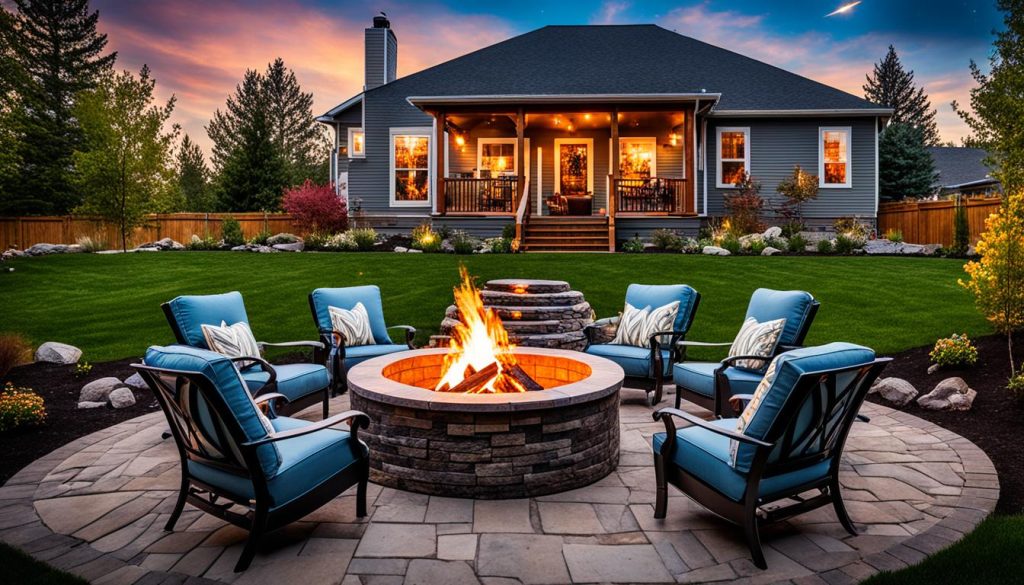
Quote:
“A DIY solo stove fire pit offers the perfect combination of portability, efficiency, and ambiance. It’s a versatile addition to any outdoor space, providing warmth and creating a cozy atmosphere for unforgettable moments.” – Outdoor enthusiast, Emily Smith
Whether you’re embarking on adventurous camping trips or simply looking to enhance your backyard gatherings, a DIY solo stove fire pit offers undeniable benefits. The portability, efficiency, smokeless fire, and atmospheric ambiance will elevate your outdoor experiences and foster a sense of togetherness.
Cost Savings of DIY Solo Stove vs. Commercial Fire Pits
Building your own DIY solo stove fire pit can save you money compared to purchasing a commercial fire pit. The materials required for the DIY version can be found at any hardware store and cost a fraction of the price of a stainless steel fire pit. By following the step-by-step instructions and using readily available materials, you can enjoy a smokeless fire pit without breaking the bank.
When comparing the cost savings of a DIY solo stove fire pit versus a commercial fire pit, the difference can be significant. The table below illustrates the potential cost savings:
| DIY Solo Stove Fire Pit | Commercial Fire Pit |
|---|---|
| Materials Cost: $100 | Price Range: $300 – $1000 |
| Build Time: 2-4 hours | Ready-to-use |
| Customizable Design | Limited Design Options |
| Portable and Easy to Transport | Fixed Location |
As you can see, the cost of materials for a DIY solo stove fire pit is significantly lower than the price range of commercial fire pits. Additionally, building your own fire pit allows for customization and a unique design tailored to your preferences.
Not only do you save money, but you also gain the satisfaction of completing a DIY project and the ability to create a fire pit that perfectly suits your needs. So why spend more on a commercial fire pit when you can experience the cost savings and personalization of a DIY solo stove fire pit?
Safety Considerations for DIY Solo Stove Fire Pit
When building and using your DIY solo stove fire pit, safety should be your top priority. Taking the necessary precautions will ensure that you can enjoy your fire pit without any accidents or mishaps.
Choose the Right Location
To prevent any potential hazards, select a location for your fire pit that is at least 10 feet away from any structures such as your house, garage, or trees. This will minimize the risk of sparks igniting unintended objects and keep everyone safe.
Follow Home Insurance Requirements
Before you begin building your fire pit, be sure to check if there are any specific requirements outlined by your home insurance policy. Some policies may have guidelines regarding fire pit placement, size, and safety measures. Adhering to these guidelines will ensure that you don’t void your insurance coverage.
Beware of Overhead Obstacles
While selecting the location for your fire pit, pay attention to any overhead obstacles such as tree branches or awnings. Make sure the fire pit is placed in an open area where there are no potential risks of falling debris or flames reaching structures overhead.
Exercise Caution with Galvanized Metal Trash Cans
If you choose to use a galvanized metal trash can as part of your fire pit setup, exercise caution during the first burn. The heat can cause the zinc coating to release toxic fumes, which can be harmful if inhaled. It’s recommended to avoid using galvanized metal trash cans altogether or opt for alternative materials.
Follow Safety Guidelines
Always follow safety guidelines and best practices when handling fire and open flames. This includes keeping a safe distance from the fire, never leaving it unattended, and having a fire extinguisher or water source nearby in case of emergencies. Educate yourself and your family on fire safety protocols to ensure a safe and enjoyable experience.
By prioritizing safety and following these guidelines, you can enjoy your DIY solo stove fire pit with peace of mind, knowing that you have taken the necessary precautions to protect yourself, your loved ones, and your property.
Additional Tips and Ideas for Your DIY Solo Stove Fire Pit
Enhance your DIY solo stove fire pit experience with these additional tips and ideas. From turning your fire pit into a cooking stove to experimenting with different wood types, these suggestions will take your outdoor gatherings to the next level.
Add a Grill Attachment
Transform your DIY fire pit into a versatile cooking stove by adding a grill attachment. This allows you to grill your favorite meats, vegetables, and even pizzas right over the fire. Enjoy the delicious smoky flavors and impress your guests with your culinary skills.
Experiment with Different Wood Types
Create unique aromas and flavors by using different wood types for your fire pit. Each wood variety adds its own distinct character to the food being cooked. Try applewood for a sweet and fruity flavor, hickory for a bold and smoky taste, or cedar for a distinctive aromatic profile.
Explore Different Firewood Sizes and Configurations
Discover the perfect combination of firewood sizes and configurations that work best for your DIY solo stove fire pit. Experiment with small kindling for a quick and intense fire, or larger logs for a slow and steady burn. Consider stacking the wood in different patterns to create mesmerizing flames and captivating visuals.
Personalize Your Fire Pit Area
Add your personal touch to the fire pit area by exploring different seating options and outdoor decor. Choose comfortable Adirondack chairs or cozy lounge seating for a relaxed atmosphere. Hang string lights or lanterns to create a warm ambiance that invites guests to linger and enjoy the crackling fire.
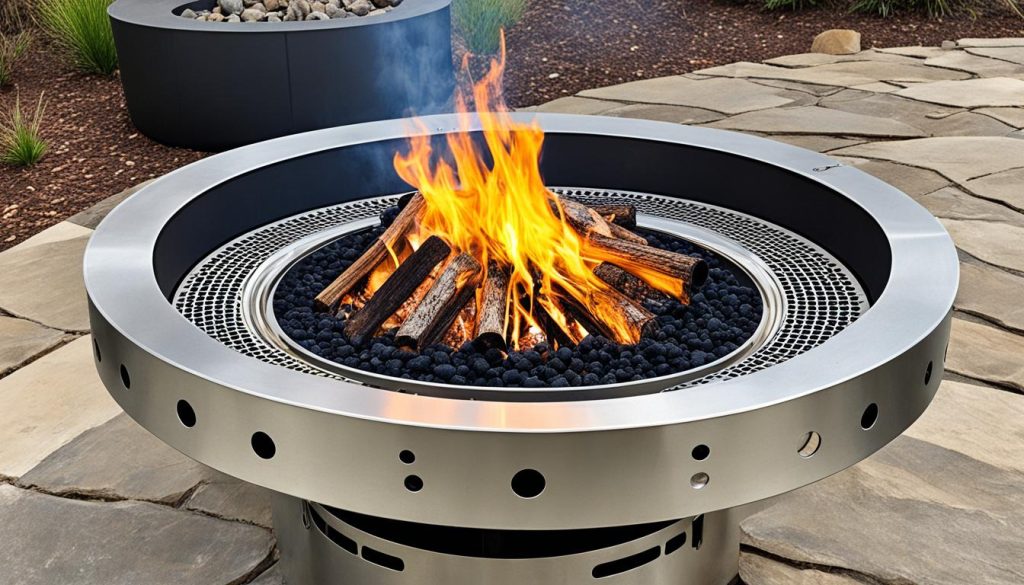
With these tips and ideas, your DIY solo stove fire pit will become the centerpiece of your outdoor space. Whether you’re grilling, enjoying the aromatic flavors of different wood types, or creating a cozy atmosphere, your fire pit will provide unforgettable experiences for all.
Maintenance and Care for Your DIY Solo Stove Fire Pit
To keep your DIY solo stove fire pit in optimal condition, regular maintenance and care are necessary. Follow these essential tips to ensure your fire pit continues to provide warmth, ambiance, and hassle-free outdoor experiences.
1. Clean out ashes and debris
After each use, it’s important to clean out the ashes and debris from your fire pit. This prevents the buildup of materials that can obstruct airflow and affect the efficiency of your fire. Use a shovel or a designated fire pit cleaning tool to remove the ashes and dispose of them properly.
2. Store firewood correctly
Proper storage of firewood is crucial for maintaining its quality and ensuring efficient burning. Store your firewood in a dry place, away from moisture and direct contact with the ground. This helps prevent mold growth and ensures that your firewood ignites easily and produces a consistent flame.
3. Check for damage or rust
Regularly inspect your DIY solo stove fire pit for any signs of damage or rust. Repair or replace any damaged parts to maintain the structural integrity and safety of the fire pit. Rust can also affect the performance of your fire pit, so addressing it promptly is essential.
4. Follow manufacturer’s guidelines
Every DIY solo stove fire pit model may have specific maintenance and care instructions provided by the manufacturer. It’s crucial to follow these guidelines to ensure you’re caring for your fire pit in the best way possible. These instructions may include additional steps for cleaning, storing, and maintaining your fire pit.
Regular maintenance and care are key to keeping your DIY solo stove fire pit in top-notch condition. By following these tips, you’ll enjoy many cozy nights and unforgettable moments around your fire pit.
With proper maintenance and care, your DIY solo stove fire pit will continue to be a reliable source of warmth and ambiance for your outdoor gatherings. Take the time to clean, store, and inspect your fire pit regularly, and enjoy the benefits of your beautifully crafted outdoor fire feature.
| Maintenance Tips | Care Suggestions |
|---|---|
| Clean out ashes and debris after each use | Store firewood in a dry place |
| Regularly check for damage or rust | Follow manufacturer’s guidelines |
Environmental Benefits of DIY Solo Stove Fire Pits
DIY solo stove fire pits offer numerous environmental benefits compared to traditional fire pits. Their efficient design allows for minimal smoke and emissions, reducing air pollution and promoting a cleaner outdoor experience. By using locally sourced firewood or recycled firewood, you can further minimize the carbon footprint associated with your fire pit and contribute to sustainable practices.
When you build and use a DIY solo stove fire pit, you have the opportunity to make eco-friendly choices. By opting for sustainably sourced firewood, you can help preserve forests and minimize deforestation. Additionally, using recycled firewood reduces waste and encourages resource conservation.
Table: Environmental Benefits of DIY Solo Stove Fire Pits
| Benefits | Description |
|---|---|
| Reduced Air Pollution | The efficient design of DIY solo stove fire pits minimizes smoke and emissions, resulting in cleaner air quality. |
| Carbon Footprint Reduction | By using locally sourced or recycled firewood, you can decrease the environmental impact of your fire pit and reduce greenhouse gas emissions. |
| Sustainable Practices | Building and using a DIY solo stove fire pit allows you to prioritize sustainability and promote eco-friendly behaviors. |
When choosing materials and maintaining your DIY solo stove fire pit, keep in mind the importance of eco-conscious decisions. Opt for natural and sustainable materials whenever possible, and dispose of ashes and debris responsibly. By embracing eco-friendly practices, you can enjoy the beauty of nature while minimizing your environmental footprint.
“Building an eco-friendly fire pit not only benefits the environment but also allows us to enjoy the outdoors responsibly, nurturing a deeper connection with nature.”
Conclusion
Building your own DIY solo stove fire pit is a rewarding and cost-effective way to enhance your outdoor experience. By following the step-by-step instructions and safety guidelines outlined in this guide, you can create a portable and smokeless fire pit that provides both warmth and ambiance.
With the right tools and materials, such as firewood, firestarters, and Solo Stove Starter Packs, you can ignite unforgettable moments around your DIY fire pit. Whether you’re camping, hosting outdoor gatherings, or simply enjoying a peaceful evening under the stars, your DIY solo stove fire pit will be the centerpiece of your outdoor adventures.
So gather your firewood, grab your firestarters, and unleash your creativity to build your own fire pit. Embrace the warmth, coziness, and beauty of an outdoor fire while enjoying the cost savings and satisfaction of creating something with your own hands. Get ready to elevate your outdoor experience with your very own DIY solo stove fire pit.
Recommended
- Buy Solo Stove: Find Your the Best Retailer Online
- Master How to Use Solo Stove – Tips & Tricks
- Understanding How Solo Stove Works | Eco-Friendly Tech

Otis, 52, embodies a lifetime of adventure, from the rugged hills of the USA to serene camping spots worldwide. His passion for the outdoors isn’t just a hobby; it’s a way of life that includes hiking, camping, and exploring the unknown. With decades of experiences under his belt, Otis shares his adventures and lessons learned through Natural Fire Pit. Beyond fire pits, his expertise in outdoor living, from setting up the perfect tent to finding off-the-beaten-path travel destinations, guides fellow enthusiasts. Follow Otis’s journey for a deeper connection with nature.
